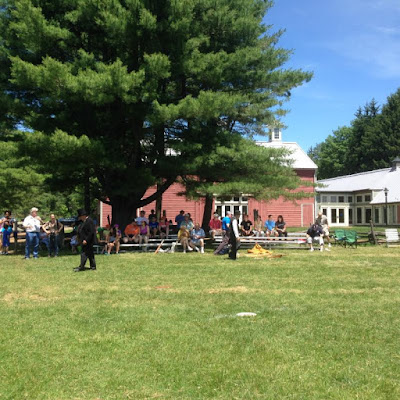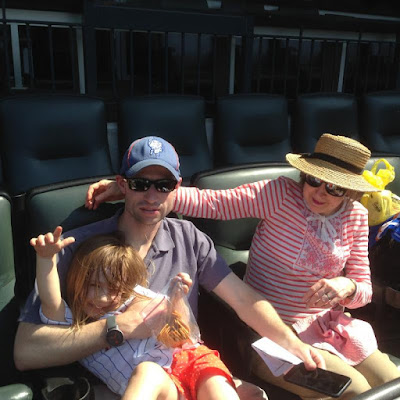Evening World - December 11, 1918
How does one make a base ball owner who died 90 years ago come alive? From what I've seen, little of Ebbets' personal correspondence, the standard raw material of history, survives, limiting the historical record of his actual words to newspaper quotes with all the risks and uncertainties thereof. Another source, of course, are the comments of his contemporaries, again primarily in newspapers which also have to be used with a certain amount of caution. In some cases, however, the sheer weight of the evidence is such that it's impossible to avoid conclusions. It would be hard to deny, for example, that Ebbets was not only talkative, but verbose. Writing in the New York Tribune in January of 1915, Heywood Broun claimed "An Ebbets sentence never comes to end. It merely cracks under the strain" of the number of words, proving the assertion by quoting in full an almost 200 word sentence which the Geneva Convention prohibits repeating here.
Brooklyn Daily Eagle, July 6, 1916 - Just one example of Ebbets donation of his park for charitable purposes
An even better way of understanding someone, however, is to look beyond what they said or what others said about them and focus on what they actually did. To me an important issue with Ebbets is whether he was really as cheap as he has been depicted by a number of modern historians. It's too early to draw definitive conclusions, but it's interesting how frequently Ebbets donated his ball park for charitable purposes. It's hard to put a dollar value on what is effectively an in-kind donation where the only cash outlays were the expense of game day staff and related items. Recently the New York Yankees donated their stadium for a charitable soft ball game and one source put the direct cost at $1 million. In 1917 in one of his many ploys to promote Sunday baseball, Ebbets paid all of the proceeds of a Sunday game to a war-related charity less $500 for the cash expenses. If that's an indication of the cost of opening the ballpark for the day, the value in 2013 dollars is almost $32,000, not an inconsiderable amount even today.
Eckford Trophy Case in the Baseball Hall of fame - note to the left the ball from the Brooklyn club's 18-12 victory over the Newark Club - New Jersey's first base ball club
Another issue of Ebbets' ownership of the Dodgers, is his attitude towards Brooklyn, did he care about the community or was he just another business man out to make a buck. One measure of someone's attitude towards their community is how much or little they value its history and in this case (literally), there is a tangible example. Back in the early days of competitive base ball, especially during the 1850's and 1860's, the winning club was awarded the game ball. It appears to have been a fairly standard practice to write the opponent and score of the game on the ball and preserve the balls in a trophy case. There is at least one surviving example, the Brooklyn Eckford's case which is on display at the Baseball Hall of Fame in Cooperstown. Another prominent Brooklyn club, the Atlantics also had such a case, reportedly containing about 100 balls, including the one from the club's epic 1870 victory that ended the Cincinnati Red Stockings record winning streak. After the club went out of existence, it's prize possession ended up in the cafe of Charley Johnston, an early backer of pugilist John L. Sullivan, on Lower Fulton Street in Brooklyn.
Atlantics' Trophy Case - now lost forever
While a number of contemporary sources claimed the club gave the case to Johnston, John Chapman, one of the last surviving members of the Atlantics wrote to Sporting Life in January of 1913 to set the record straight by noting that the case passed through several parties who had no right to it before it finally ended up with Johnston who also had no legitimate claim. According to Chapman, Johnston refused to return the case to the surviving club members unless he received "a large amount" as compensation, an amount the aging players either couldn't or wouldn't pay. Upon Johnston's death in 1905, considerable "agitation" took place about the fate of the historic collection, but even Henry Chadwick's suggestion of a public subscription to purchase the case for the Brooklyn Museum of Arts and Sciences proved unsuccessful. Finally seven years later in October of 1912, riding to the rescue on a metaphorical white horse was Charles Ebbets (and the McKeevers) who purchased the case for display in the rotunda at Ebbets Field. It's not clear if it was ever displayed there and I have my doubts.
New York Clipper - November 29, 1879
Although no cost was mentioned, the inability of anyone else to acquire the prize baseballs before or after Johnston's death, suggests the cost wasn't insignificant. Regardless of the cost, however, the importance lies in Ebbets, who was so overwhelmed in finishing Ebbets Field that he had to take a cruise for his health, spending the time and money to cement the connection between his brand new state of the art ball park with the game's long and distinguished history in Brooklyn. It's another example of how deeply Ebbets' life was embedded in Brooklyn. Ebbets also made it a point to participate in Chapman's 1916 funeral, a fitting way for one member of the Brooklyn Elks to honor one of the lodge's charter members. Any final doubts about the significance of Ebbets' action can be seen in the final fate of the case. According to Peter Nash in Baseball Legends of Brooklyn's Green-Wood Cemetery, the case was broken up by the one and only Walter O'Malley who supposedly gave the balls away to departing employees. You can't make this stuff up!

































